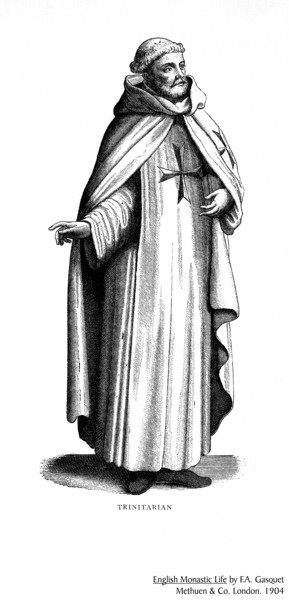On this page you
will
find some information regarding the Trinitarians, also known as Friars
of the Holy Trinity, or the Materines. Included is information from
Abbot
Gasquet's book English
Monastic
Life. Gasquet published the book through The Antiquaries
Book
series in
1904. It is now out of print and not generally available.
There may
be a number of factual errors in the text, or points on which
historians or theologians do not agree. Gasquet's
text, notes & links>>
|
 |
|
The Friars
The friars
differed from the monks
in certain ways. The brethren by their
profession were bound, not to any locality or house, but to the
province, which
usually consisted of the entire number of houses in a country. They did not, consequently, form individual
families in their various establishments, like the monks in their
monasteries. They also, at first,
professed the strictest poverty, not being allowed to possess even
corporate
property like the monastic Orders. They
were by their profession mendicants, living on alms, and only holding
the mere
buildings in whey they dwelt.
The Lesser Friars
Friars of the holy Trinity,
or Trinitarians
These
religious were founded by SS. John of Matha and Felix of Valois about A.D.
1197
for the redemption of captives. They
were called “Trinitarians,” because
by their rule all their churches were dedicated to the Holy Trinity, or
“Maturines,” from the fact that their
original foundation in Paris
was
near St. Mathurine’s Chapel. The Order
was confirmed by Pope Innocent III., who gave the religious white
robes, with a
red and blue cross on their breasts, and a cloak with the same emblem
on the
left side. Their revenues were to be
divided into three parts ; one for their own support, one to relieve
the poor,
and the third to ransom Christians who had been taken captive by the
infidels. They were brought to England
in A.D. 1244, and were given the lands and privileges
of the Canons of the Holy
Sepulchre on the extinction of that order. According
to the Monasticon,
they had, in all, eleven houses in this country ; but these
establishments were
small, the usual number of religious in each being three friars and
three lay
brothers. The superior was named
"minister," and included
in his office the functions of superior and procurator ; and the houses
were
united into a congregation under a Minister
major, who held a general Chapter annually for the regulation of
defects
and the discussion of common interests.
English
Monastic Life by
F.A. Gasquet. (pages 234 & 245-246.)
|
Trinitarian Houses in England (Gasquet doesn't give and
Trinitarian Houses in England, likely because the order was so short
lived. For more English
Religious Houses, see the index page):
Trinitarianhistory.org lists the names (and more,
see link below) of the Trinitarian Houses in England, Scotland and
Ireland as follows:
England:
Hounslow
Mottenden
Thelsford
Easton Royal
Knaresborough
Totnes
Hertford
Oxford
Walknoll
Ingham
And possibly
St. Bartholomew's in Durham
|
Scotland:
Berwick-upon- Tweed
Dunbar
Failford
Scotlandwell
Houston
Aberdeen
Peebles
Dirleton
|
Ireland:
Adare
|
|
Trinitarian Links:
'Friaries: The
Trinitarian friars of Knaresborough', A History of the County
of York: Volume 3 (1974), pp. 296-300. British History
Online.
'Religious Houses:
House of Trinitarian friars', A
History of the County of Middlesex: Volume 1: Physique, Archaeology,
Domesday, Ecclesiastical Organization, The Jews, Religious Houses,
Education of Working Classes to 1870, Private Education from Sixteenth
Century (1969), pp. 191-93. British History Online,
'Hospitals:
Hospital of the Holy Sepulchre, Nottingham', A History of the
County of Nottingham: Volume 2 (1910), p. 168. British
History Online.
Corrections,
questions?  |
|
Historyfish
pages, content, and design copyright (c) Richenda
Fairhurst, 2008
All rights reserved. No commercial permissions are
granted.
The Historyfish site, as a particular and so
unique "expression," is copyright. However, some (most) source
material is part of the public domain, and so free of copyright
restrictions. Where those sections are not clearly marked, please
contact me so I can assist in identifying and separating that material
from the Historyfish site as a whole.
When using material from this site, please
keep
author, source, and
copyright permissions with this article.
Historyfish intends to generate discussion through shared
information and does not claim to provide,
in any way, formal, legal, or factual advice or information. These
pages are opinion only. Opinions shared on historyfish are
not necessarily
the
opinions of historyfish editors, staff, owners or
administrators. Always consult
proper authorities with questions pertaining to copyrights, property
rights, and intellectual property rights.
It is my intent to follow copyright law (however impossibly convoluted
that may be). Please contact me should any material included here be
copyright protected and posted in error. I will remove it from the
site. Thank you. |
|
